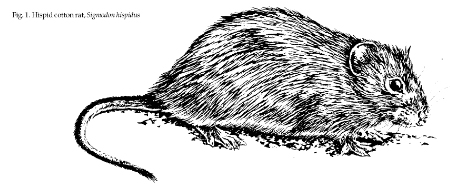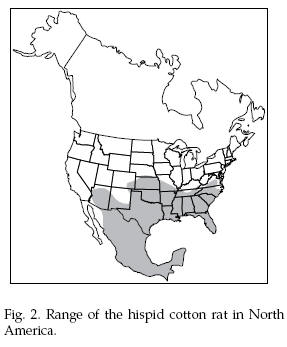|
|
|
|
 |
RODENTS: Cotton Rats |
|
|

Fig. 1. Porcupine,
Erethizon dorsatum
Damage
Prevention and Control Methods
- Exclusion
Usually not practical
- Cultural Methods
Remove dense vegetation
- Repellents
Not effective
- Toxicants
2% zinc phosphide on dry bait.
- Fumigants
Not practical.
- Trapping
Snap traps (rat traps). , Live traps.
- Shooting
Not practical.
Identification
The hispid cotton rat (Sigmodon
hispidus) is a moderately large, robust rodent with
a scaly, sparsely haired tail that is shorter than the
combined head and body.
Cotton rats have
relatively large eyes. The ears are large but almost
hidden in the fur. They have four toes and a small thumb
on their front feet and five toes on each hind foot. The
cotton rat has very small internal cheek pouches.
Distinguishing characteristics are the rough grizzled
appearance of the blackish or grayish fur and the rather
stiff black guard hairs. This rodent has a high “Roman”
nose and color similar to that of a javelina, resulting
in the name “javelina rat” in many areas.
The total length averages
10 inches (25 cm) including the tail length of 4 inches
(10 cm). The cotton rat may be distinguished from the
Norway rat by its smaller size, shorter tail, and longer
grizzled fur. Evidence of cotton rat presence are stem
and grass cuttings 2 or 3 inches (5 or 8 cm) in length
piled at various locations along runways, which are 3 to
5 inches (8 to 13 cm) wide. Pale greenish or yellow
droppings, about 3/8 inch (9 mm) in length and 3/16 inch
(5 mm) in diameter, may also be present along the
runways.

Range
The hispid cotton rat occurs over most of the
southern United States, from the southeastern tip of
California, southern Arizona and New Mexico, north to
eastern Colorado, eastward through the southern portions
of Kansas and Missouri, through Tennessee and North
Carolina, and southward along the Atlantic coast through
Florida, the Gulf states, and up the Rio Grande Valley
(Fig. 2).
Two other species of
cotton rat, the least cotton rat (S. minimus) and the
yellownose cotton rat (S. ochrognathus), occur only in
small areas of southeastern Arizona and southwestern New
Mexico. They are very similar to the hispid cotton rat.
Habitat
Cotton rats prefer dense
cover such as grassy fields, overgrown roadsides, or
fencerow vegetation adjacent to cultivated fields. They
also occupy meadows, marshy areas, cactus patches, and
weedy ditch banks. Under the protective cover, the
cotton rat will have well-defined runways radiating in
all directions from the nest site.
Food Habits
Cotton rats are normally
herbivores, eating the roots, stems, leaves, and seeds
of a wide variety of plants. They also feed on
sugarcane, fruits, berries, and nuts. Cotton rats will
cut tall plants off at the base and continue to cut them
into shorter sections. They also eat insects, the eggs
and young of ground-nesting birds (particularly quail),
and the carcasses of dead animals.
General
Biology, Reproduction, and Behavior
Cotton rats are basically
nocturnal but will venture out in the daytime and are
active year-round. The home range is small — from 1/4 to
3/4 acre (0.1 to 0.3 ha) for females and 1 to 1 1/4
acres (0.4 to 0.5 ha) for males. Cotton rats do not
store food or hibernate. They can swim and do not
hesitate to do so. This species is excitable,
pugnacious, and aggressive toward mice living in the
same fields. Their nests are a crude mass of dry grass
fibers stripped from larger plant stems, placed in
shallow surface depressions, among clumps of coarse
grasses, underground in shallow tunnels, or under rocks
or logs.
The species is very
prolific and will breed throughout the year. Several
litters may be produced annually, averaging 2 to 15
young per litter. The gestation period is 27 days, and
the young are weaned in 10 to 15 days.
Most young breed for the
first time at 2 to 3 months of age. Therefore, several
generations may live in the same nest at one time. The
average life span is 6 months.
Damage
Cotton rat populations
fluctuate greatly, ranging from 11 to 149 per acre (28
to 373/ha), and cause the most serious damage during
population peaks. They may damage a variety of crops,
including alfalfa, grains, grasses, vegetables, peanuts,
fruit crops, sweet potatoes, and sugar beets. Cotton
rats are especially troublesome in sugarcane and melons.
Since these animals will eat quail eggs, a high cotton
rat population may have a detrimental impact on quail
nesting success. Cotton rats also compete with quail for
the same foods.
Legal Status
Cotton rats are not
protected in most states; some states classify them as
nongame mammals. They may be taken if causing damage.
Check local and state laws before beginning control
measures.
Damage
Prevention and Control Methods
Exclusion
If the area is
small or the crop to be protected is of high value, a
sheet-metal barrier 18 inches (46 cm) tall may be used
to exclude cotton rats. Bury the barrier about 6 inches
(15 cm) to prevent cotton rats from burrowing under it.
Cultural Methods
Remove dense
cover by burning, mowing, plowing, or the use of
herbicides to reduce habitat and prevent large
population increases. Habitat modification is best as a
preventive measure, since this control method will have
little effect on the ensuing damage once a population
reaches its peak.
Repellents
None are
registered for repelling cotton rats.
Toxicants
Only zinc
phosphide (2% active ingredient) is currently registered
and being marketed for cotton rat control, and its use
is limited to sugarcane fields. When applying toxic
bait, lightly scatter teaspoon quantities in the rats’
runways at 12- to 30-foot (3.6- to 9-m) intervals
according to label instructions.
Fumigants
Fumigants are
not very practical because cotton rats use their burrows
and tunnels infrequently. Since state pesticide
registrations vary, check with the local extension
office or state wildlife agency for information on
repellents, toxicants, and fumigants in your area.
Trapping
Small rodent
live traps or rat-sized snap traps are effective for
catching a small number of animals. The traps should be
baited with a mixture of peanut butter and oatmeal or a
piece of fresh carrot or sweet potato. The trap should
be set in the runway at a right angle to the direction
of travel.
Economics of Damage and
Control The amount and extent of damage is directly
related to the relative density of the cotton rat
population. The cost of control must be weighed against
the value of the crop to be protected, such as sugarcane
or melons.
Acknowledgments
Figures 1 and 2 from
Schwartz and Schwartz (1981), adapted by Jill Sack
Johnson.
For Additional
Information
Camedon, G. N., and S. R.
Spencer. 1981. Sigmodon hispidus. Mammal. Sp. 158:1-9.
Clark, D. O. 1972. The
extending of cotton rat range in California — their life
history and control. Proc. Vertebr. Pest Conf. 5:7-14.
Clark, J. P. 1986.
Vertebrate pest control handbook. California Dept. Food
Agric. Sacramento. 615 pp.
Editors
Scott E. Hygnstrom, Robert
M. Timm, Gary E. Larson
PREVENTION AND CONTROL OF
WILDLIFE DAMAGE — 1994
Cooperative Extension
Division Institute of Agriculture and Natural Resources
University of Nebraska -Lincoln
United States Department
of Agriculture Animal and Plant Health Inspection
Service Animal Damage Control
Great Plains Agricultural
Council Wildlife Committee
04/05/2006
Special
thanks to:
Clemson University
|